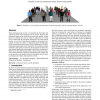Free Online Productivity Tools
i2Speak
i2Symbol
i2OCR
iTex2Img
iWeb2Print
iWeb2Shot
i2Type
iPdf2Split
iPdf2Merge
i2Bopomofo
i2Arabic
i2Style
i2Image
i2PDF
iLatex2Rtf
Sci2ools
97
Voted
TOG
2008
2008
Clone attack! Perception of crowd variety
When simulating large crowds, it is inevitable that the models and motions of many virtual characters will be cloned. However, the perceptual impact of this trade-off has never been studied. In this paper, we consider the ways in which an impression of variety can be created and the perceptual consequences of certain design choices. In a series of experiments designed to test people's perception of variety in crowds, we found that clones of appearance are far easier to detect than motion clones. Furthermore, we established that cloned models can be masked by color variation, random orientation, and motion. Conversely, the perception of cloned motions remains unaffected by the model on which they are displayed. Other factors that influence the ability to detect clones were examined, such as proximity, model type and characteristic motion. Our results provide novel insights and useful thresholds that will assist in creating more realistic, heterogeneous crowds. CR Categories: I.3.7...
| Added | 15 Dec 2010 |
| Updated | 15 Dec 2010 |
| Type | Journal |
| Year | 2008 |
| Where | TOG |
| Authors | Rachel McDonnell, Michéal Larkin, Simon Dobbyn, Steven Collins, Carol O'Sullivan |
Comments (0)

